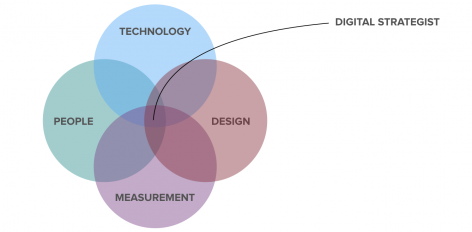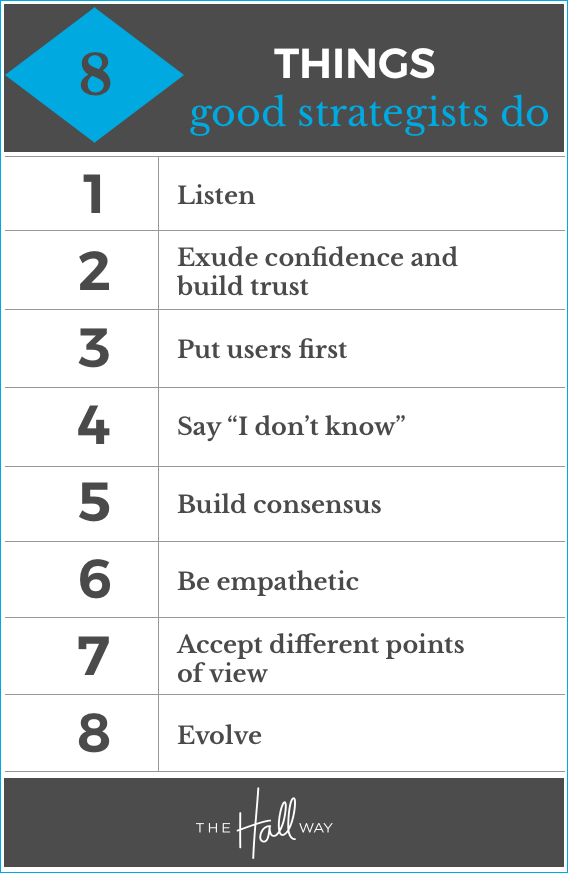How would you explain a digital strategist’s job to students?
There’s no better moment to revisit the principles and merits of your profession than before explaining them to students. Last fall, I spoke about digital strategy to really engaged students in the Advertising and Marketing Communications Management program at Algonquin College. While I prepared the talk and in the conversation afterward, I was reminded of what it takes to be great at my job. It’s been helpful to remember these principles as I tuck into new and challenging projects. If you want to be a great digital strategist OR want to work with one, revisit these basics and see if they resonate with you.
Move organizations from A to B
It’s no wonder students are curious about the term digital strategy. It’s overused and ill-defined. The students I interacted with had great questions, including “What is a digital strategist? What does one really do? How do you learn to be strategic?”
I told them a digital strategist helps an organization get from a current state to a desired state around a particular challenge. Sometimes current states and desired states are clear and simple, and sometimes they’re complex. Here are some of the real-world examples I shared:
- A university wants to better use digital analytics by identifying clear targets and creating a corresponding measurement and tracking system.
- A healthcare organization needs help identifying which digital skills it needs and a plan to train and hire for those skills.
- A city has a hard time ensuring that all of its digital assets provide comparable user experiences, and meet the same standards and legislative requirements. It wants to conduct an assessment and create a plan for delivering these consistent experiences across all digital touchpoints.
- A large retail chain needs to better understand its customers before it chooses the right mobile strategy for its business.
These are real challenges I’ve faced in my work. In each of these scenarios, I’ve worked with my clients to develop plans and tactics to move them in the right direction. What’s strategic about that? I had to gather and assess information in order to get a real picture of their current state, determine an appropriate end goal, and then create a plan to move us to that goal. That requires a lot of strategic thinking and a very special skill set.
It begins and ends with people
The “digital” in digital strategist doesn’t mean we work solely in technology. While we do work there, it’s a small part of where we spend our days. A good strategist is interested in people, design, technology, and analytics. The problems we solve begin and end with people. Only when we truly understand what they need can we design a solution and analyze whether it works.
Strategists are like good detectives
Strategists are not afraid to ask questions, and we don’t take answers at face value. We dig. When you answer one of our questions, we’ll come back at you with more. We know that challenges and opportunities are always deeper than what we see on the surface.
Over the years, I’ve worked with colleagues who’ve sold clients on solutions before I was convinced we fully understood their problems. Great strategists know that solid plans are based on a lot of up-front, time-consuming tasks that get to the root of problems:
- Conducting interviews and asking difficult questions
- Documenting requirements
- Conducting research and observing users
- Analyzing data
When that work is done, we better understand the who, what, when, where, and why of a given problem. That kind of information is what we use to create actionable and measurable plans.
My top eight
Not everyone has the patience and tenacity required to be a digital strategist. When the students at Algonquin asked me what it takes to be a great one, my answers came fast and furious. Here are the top eight traits and behaviours I mentioned:
1. Listen
We don’t get to the heart of a problem by talking. We do it by listening. Since digital strategists solve problems, we have to be good at listening. (Like, therapist-level good.) Turns out, this skill is pretty handy in the rest of life too. People love being heard, and the more they are listened to, the more they respond. Go ahead, try it. Ask good questions and then be quiet.
2. Exude confidence and build trust
Like listening, building trust is essential to our success. Studies show that when people first meet us, they evaluate how warm and trustworthy we are and then how competent we are. Projecting an air of warmth, confidence, and good judgement is critical to getting people to trust us.
Why is that important? Because clients and partners need to believe we have their best interests at heart. They will only be open and honest if they trust us, and that’s a must if we’re going to do our job well.
3. Put users first
The best and fastest way to help an organization is to help its target audience. Organizations tend to design for themselves instead of the people who use their digital products and services. We must always advocate for users and ensure that they’re at the center of decisions. We help organizations design what users need rather than what organizations want to give them.
4. Say “I don’t know”
Clients hire us to solve problems. They expect a lot from us and we get asked difficult questions, especially if we’re trusted. Don’t be tempted to answer questions prematurely, or worse, make up answers. Trust comes from authenticity and that means being comfortable saying “I don’t know”. That doesn’t mean you’ll never have the answer, it means you’ll provide it once you’ve arrived at it thoughtfully.
5. Build consensus
Digital strategists constantly try to satisfy the needs and wishes of a wide range of stakeholders. It’s possibly the most difficult aspect of our job. The best way to build consensus and get agreement on plans is to remain flexible. Do this by offering a range of solutions from “the most acceptable” to “the least acceptable”.
6. Be empathetic
The strength of our working relationships and our ability to design influential solutions relates directly to how well we understand people’s feelings, unique context, and point of view. Express that through phrases like these:
“I imagine you’re feeling …”
“Help me to understand …”
“I’m listening …”
The positive results that come from displaying empathy in the workplace will astound you.
7. Accept different points of view
People gravitate toward those who share their point of view. That natural bent is reinforced everywhere today — just look at how social media channels work. It’s hard to seek out different points of view (and even harder to accept them). But when we do, we increase the scope of our learning and are better able to design comprehensive solutions for clients. Whenever you feel yourself reacting against someone’s point of view, hit pause. See if you can explore that reaction and learn from their perspective, even if it’s tough.
8. Evolve
You can’t design and recommend the best solutions if you’re operating from a narrow field of view. Take time to learn new approaches and ideas (see point #7). Take on projects that are outside your comfort zone. Try to work at the edges of what’s known and operate in a visionary way. Stay on top of the best practices in your field.
What do you think?
The students I met seemed surprised to learn that strategy is merely about establishing a plan to get from one place to another — it’s that simple, even though the problems can be tough to solve. They also understood why I stressed the need for certain skills in this line of work.
Afterward, several admitted they weren’t sure strategy was the right path for them (a deeper creative / artistic direction seemed more appealing), while others were utterly pumped to complete their studies, roll up their sleeves, and dive in. I look forward to seeing where they land and what they get up to!
I’m curious to know what you think. Anything you’d add to my list of key behaviours and traits for being a great digital strategist or a strategist in general?
Have a business challenge that you’d like to explore during a half- or full-day workshop? Need a speaker for an event? Interested in team training? Get in touch with me for keynotes, workshops, and panel discussions. I speak about: defining and expressing your value proposition, building your digital roadmap, upping your organization’s digital skills, and more.


